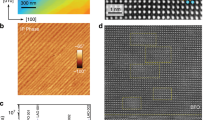Abstract
Ferroelectric oxides, such as Pb(Zr,Ti)O3, are useful for electronic and photonic devices because of their ability to retain two stable polarization states, which can form the basis for memory and logic circuitry1. Requirements for long-term operation of practical devices such as non-volatile RAM (random access memory) include consistent polarization switching over many (more than 1012) cycles of the applied electric field, which represents a major challenge2. As switching is largely controlled by the motion and pinning of domain walls, it is necessary to develop suitable tools that can directly probe the ferroelectric domain structures in operating devices—thin-film structures with electrical contacts. A recently developed synchrotron X-ray microdiffraction technique complements existing microscopic probes, and allows us to visualize directly the evolution of polarization domains in ferroelectric devices, through metal or oxide electrodes, and with submicrometre spatial resolution. The images reveal two regimes of fatigue, depending on the magnitude of the electric field pulses driving the device: a low-field regime in which fatigue can be reversed with higher electric field pulses, and a regime at very high electric fields in which there is a non-reversible crystallographic relaxation of the epitaxial ferroelectric film.




Similar content being viewed by others
References
Scott, J.F. Ferroelectric Memories (Springer, Berlin, 2000).
Tagantsev, A.K., Stolichnov, I., Colla, E.L. & Setter, N. Polarization fatigue in ferroelectric films: Basic experimental findings, phenomenological scenarios, and microscopic features. J. Appl. Phys. 90, 1387–1402 (2001).
Dawber, M. & Scott, J.F. A model for fatigue in ferroelectric perovskite thin films. Appl. Phys. Lett. 76, 1060–1062 (2000).
Larsen, P.K., Dormans, G.J.M., Taylor, D.J. & van Veldhoven, P.J. Ferroelectric properties and fatigue of PbZr0.51Ti0.49O3 thin films of varying thickness: Blocking layer model. J. Appl. Phys. 76, 2405–2413 (1994).
Nagarajan, V. et al. Dynamics of ferroelastic domains in ferroelectric thin films. Nature Mater. 2, 43–47 (2002).
Colla, E.L. et al. Direct observation of region by region suppression of the switchable polarization (fatigue) in Pb(Zr, Ti)O3 thin film capacitors with Pt electrodes. Appl. Phys. Lett. 72, 2763–2765 (1998).
Gruverman, A., Auciello, O. & Tokumoto, H. Imaging and control of domain structures in ferroelectric thin films via scanning force microscopy. Annu. Rev. Mater. Sci. 28, 101–123 (1998).
Rogan, R.C., Tamura, N., Swift, G.A. & Üstündag, E. Direct measurement of triaxial strain fields around ferroelectric domains using X-ray microdiffraction. Nature Mater. 2, 379–381 (2003).
James, R.W. The Optical Principles of X-ray Diffraction 33 (Cornell Univ. Press, Ithaca, New York, 1965).
Wallace, C.A. The display of twinning in lithium niobate by x-ray diffraction topography. J. Appl. Crystallogr. 3, 546–547 (1970).
Vreeland, T. & Speriousu, V.S. in Applications of X-ray Topographic Methods to Materials Science (eds Balibar, F. & Petroff, J.-F.) 501–509 (Plenum, New York, 1984).
Coster, D., Knol, K.S. & Prins, J.A. Difference in the intensities of x-ray reflection from the two sides of the 111 plane of zinc blende. Z. Phys. 63, 345–369 (1930).
Colla, E.L., Tagantsev, A.K., Taylor D.V. & Kholkin, A.L. Fatigued state of the Pt-PZT-Pt system. Integr. Ferroelectr. 18, 19–28 (1997).
Scott, J.F. & Pouligny, B.J. Raman spectroscopy of submicron KNO3 films. II. Fatigue and space-charge effects. J. Appl. Phys. 64, 1547–1561 (1988).
Auciello, O. et al. Review of composition-structure-property relationships for PZT-based heterostructure capacitors. Integr. Ferroelectr. 6, 173–187 (1995).
Eom, C.B. et al. Fabrication and properties of epitaxial ferroelectric heterostructures with (SrRuO3) isotropic metallic oxide electrodes. Appl. Phys. Lett. 63, 2570–2572 (1993).
Duiker, H.M. et al. Fatigue and switching in ferroelectric memories: theory and experiment. J. Appl. Phys. 68, 5783–5791 (1990).
Thompson, C. et al. X-ray scattering evidence for the structural nature of fatigue in epitaxial Pb(Zr, Ti)O3 films. Appl. Phys. Lett. 78, 3511–3513 (2001).
Jiang, A. et al. Studies of switching kinetics in ferroelectric thin films. Jpn. J. Appl. Phys. 42, 6973–6982 (2003).
Eom, C.B. et al. Single-crystal epitaxial thin films of the isotropic metallic oxides Sr1−xCaxRuO3 (0 ≤ x ≤ 1). Science 258, 1766–1769 (1992).
Noheda, B. et al. A monoclinic ferroelectric phase in the Pb(Zr1−xTix)O3 solid solution. Appl. Phys. Lett. 74, 2059–2061 (1999).
Grossmann, M. et al. Correlation between switching and fatigue in PbZr0.3Ti0.7O3 thin films. Appl. Phys. Lett. 77, 1894–1896 (2000).
Cai, Z., Lai, B., Xiao, Y. & Xu, S. An X-ray diffraction microscope at the Advanced Photon Source. J. Phys. IV 104, 17–20 (2003).
Lai, B. et al. Hard X-ray phase zone plate fabricated by lithographic techniques. Appl. Phys. Lett. 61, 1877–1879 (1992).
Acknowledgements
This work was supported by the National Science Foundation through the University of Wisconsin Materials Research Science and Engineering Center (grant number DMR-0079983) and grant no. DMR-0313764 (C.B.E.). Use of the Advanced Photon Source was supported by the US Department of Energy, Office of Science, Office of Basic Energy Sciences (contract number W-31-109-Eng-38). E.D. acknowledges support from the US Department of Energy (grant numbers DE-FG02-03ER46023 and DE-FG02-00ER15031), and from the NSF FOCUS physics frontier centre.
Author information
Authors and Affiliations
Corresponding author
Ethics declarations
Competing interests
The authors declare no competing financial interests.
Rights and permissions
About this article
Cite this article
Do, DH., Evans, P., Isaacs, E. et al. Structural visualization of polarization fatigue in epitaxial ferroelectric oxide devices. Nature Mater 3, 365–369 (2004). https://doi.org/10.1038/nmat1122
Received:
Accepted:
Published:
Issue Date:
DOI: https://doi.org/10.1038/nmat1122
- Springer Nature Limited
This article is cited by
-
In situ observation of atomic movement in a ferroelectric film under an external electric field and stress
Nano Research (2018)
-
Thin-film ferroelectric materials and their applications
Nature Reviews Materials (2016)
-
The use of diffraction in the characterization of piezoelectric materials
Journal of Electroceramics (2007)
-
Observation of subnanometre-high surface topography with X-ray reflection phase-contrast microscopy
Nature Physics (2006)





